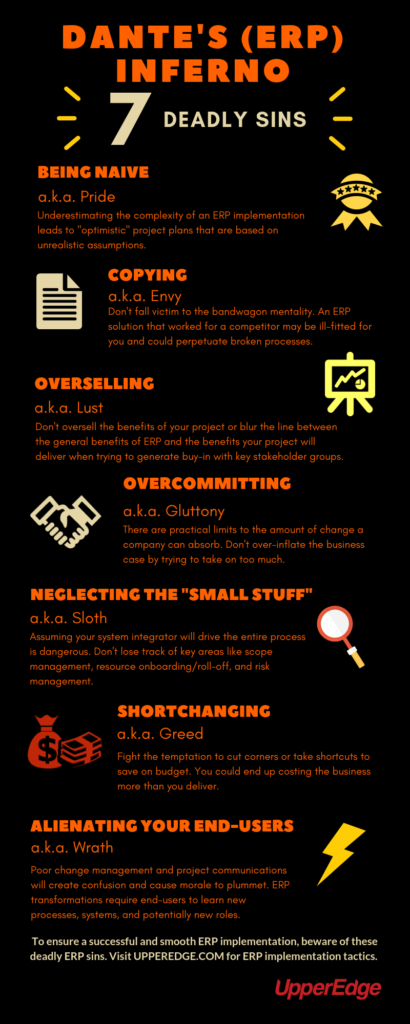- Shawn Stamp
- Reading Time: 6 minutes

ERP implementation projects are large, complex endeavors that can quickly spiral out of control. Blown budgets and delayed implementations are not uncommon, and in the worst cases, failed ERP projects can cripple the entire organization. Despite risk management frameworks, robust development methodologies, and highly motivated teams, ERP initiatives still fall victim to poor decisions. In his “Divine Comedy”, Dante chronicles his journey through the nine circles of hell. To avoid a similar story for your ERP project, beware of these deadly ERP sins.
1. Copying (Envy)
Don’t assume that since a system worked out for the competition that it will deliver the same benefits for your organization. While this may in fact be the case, ERP solutions are the means to the end, not the end themselves. The value from ERP comes from the transformation and process improvements they enable, so falling victim to the bandwagon mentality could lead to an ill-fitted solution that simply perpetuates broken processes.
Moreover, platform selection is just the tip of the iceberg. Every system integrator (SI) has different strengths and weaknesses relative to your organization, and selecting a partner based upon your competitor’s success (or conversely their failure) could be a recipe for disaster.
Safeguard: Make sure to understand what you are trying to accomplish before launching into an ERP initiative. Not only will the vision help to ensure you select the platform that best supports your objectives, but it also positions your organization to avoid the next pitfall by serving as the foundation for the business case.
2. Overselling (Lust)
When attempting to generate buy-in with key stakeholder groups, it can be tempting to blur the line between the general benefits of ERP and the benefits your project will actually deliver. Properly setting and managing expectations is key to the success of your project (not to mention your career) because overselling the benefits of a project will backfire when those perceived promises are broken. If significant benefits are too far downstream and don’t materialize until the “next” project, you will lose credibility with key stakeholders and potentially fuel resistance to further change.
Safeguard: Take the time to establish a solid business case that sets realistic expectations about the benefits the project will deliver. This is critical both to maintaining continued support for the project as well as measuring overall success.
3. Overcommitting (Gluttony)
Even if you resist the urge to overstate the project’s benefits, be careful not to over-inflate the business case by trying to take on too much. Just as gorging on a Thanksgiving feast can lead to an afternoon of misery, organizations whose “eyes are bigger than their bellies” could find themselves regretting their appetite for years to come.
In other words, regardless of how big the payoff may be, there are practical limits to the amount of change a company can absorb. Even though that threshold may vary widely from one organization to the next, the reality is that it is impossible do everything all at once.
Safeguard: Organizations have limited resources and ERP projects are disruptive by nature, so companies need to be realistic when evaluating both the scope and timing of their ERP transformations. It may be necessary to reduce scope (hence benefits) so that the project is achievable or defer the project so that it doesn’t collide with other “top priority” projects. Business cycles, competing projects, and even the organization’s culture need to be taken into consideration when building a business case to make sure you are positioning your project for success.
Blog continued below. [Click graphic to enlarge]
4. Shortchanging the Process (Greed)
As the go-live date gets closer, the pressure on both timelines and budgets intensifies. There is less room for error, it’s harder to recover from setbacks, and even small changes become increasingly costly. When project teams find themselves in this position—as they typically do—the temptation to cut corners can seem like a reasonable way to relieve the pressure. But do not be fooled: taking shortcuts to save on budget virtually guarantees an inferior solution in the end. If you are lucky, it can be fixed later; if you aren’t, you could end up costing the business more than you deliver. So, think twice before skimping on any of the following aspects of your project:
- Training and education – Your ERP solution is only as good as those who know how to use it.
- Dress rehearsals – Practice exposes potential gaps or issues in the deployment plan. Trying to stay on track by cutting out the dress rehearsal is not worth the risk.
- Customization – “Standard functionality” is certainly a worthwhile goal, but not if it dilutes or otherwise jeopardizes your benefits case. Beware of this “shortcut” that can leave companies with an ill-fitted, underperforming solution.
- Testing – Cutting back on the scope or number of either testing cycles or mock conversions is a bad idea. You want to uncover issues before the system is installed, not after.
- Resources – Your process is only as good as the people who are executing it, so be sure to plan for adequate backfill capacity.
Safeguard: Given the complexity and length of these projects, surprises are bound to pop up. Plan ahead, anticipate change, and be sure to build some contingencies in both budget and schedule. Lastly, if your best efforts still aren’t good enough to keep things on-time and on-budget, be prepared for some tough discussions with your steering committee.
5. Neglecting the “Small Stuff” (Sloth)
Just because your SI has brought proven processes and toolsets to the table, don’t fall into the trap of thinking that you can coast to the finish line and/or simply let the SI drive the process. A good plan is just the tip of the iceberg and haphazard execution will eventually cripple a project. To enable efficient program and project management, organizations need to diligently track, report on, and drive key processes like:
- Scope management
- Resource onboarding/roll-off
- Issues and risk management
- Decision Making
Losing track of these key areas leads to confusion, rework, delays…and some unpleasant change orders. Even when your SI has assumed the “master conductor” role, it is imperative that your organization invests the proper amount of time and energy to making sure that everyone is doing their part.
Safeguard: Establish clear metrics for each of these processes up front, and make sure to track and report on them regularly. For example, how many days can an issue be open before it is either resolved or escalated? What turnaround time do you expect for key decisions?
6. Alienating Your End-users (Wrath)
ERP transformations are all about change, requiring end-users to learn new business processes, systems, and potentially new roles. While some stakeholders will optimistically welcome the changes, there will always be some who skeptically resist. Moreover, as the issues begin to surface, goodwill can quickly evaporate, and supporters will defect to the “dark side” if they aren’t getting clear direction and answers from project leadership. This is why a strong communications plan is such a critical component of the overall change management strategy.
Project communications need to be intentional, transparent, and proactive since any deficiencies in either the cadence or the content of your communications can quickly lead to confusion and spark resentment amongst end-users. The project will start to feel “heavy handed” and forced upon them, the rumor mill will inevitably “fill in the blanks”, and morale will plummet. The best defense is a robust communications plan that continually reinforces your vision, honestly addresses issues and challenges, and engages the business.
Safeguard: Someone in your organization will be providing the “color commentary” on everything happening within the project, so make sure that your message is the loudest and the clearest. Just as “location, location, location” is the mantra for any realtor, “communicate, communicate, communicate” should be the refrain of your project team. Not only does this help convey key messages and continually reinforce the vision, it also helps counteract the impact of the rumor mill.
7. Being Naive (Pride)
Despite countless ERP horror stories, organizations still tend to underestimate the complexity associated with implementing ERP. This leads to “optimistic” project plans that are based on unrealistic or even dangerous assumptions. For example, an organization’s data is almost always worse than they think, even if their source system is another ERP platform. Companies tend to assume that if the business is running today, then the data must be good enough for the new system; however, there are always gaps in the data and subsequent manual workarounds that don’t surface until the first mock conversion…or worse, the second one. Furthermore, legacy system integrations and testing are almost always harder and more complex than they are expected to be.
Safeguard: In short, what you don’t know will cost you. Ignorance is anything but bliss when it comes to ERP projects, so expect surprises. Practically speaking, this means that unless you want to go back to your board of directors and ask for more money, make sure to include a healthy contingency in the budget. Chances are good that you will need it.
Follow me on Twitter @sstamp_ue. Find my other UpperEdge blogs and follow UpperEdge on Twitter and LinkedIn.

